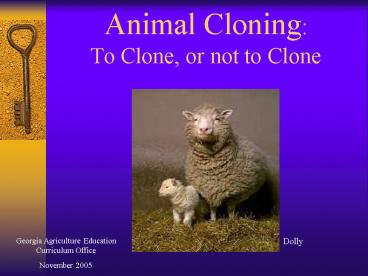Animal Cloning: To Clone, or not to Clone - PowerPoint PPT Presentation
1 / 21
Title:
Animal Cloning: To Clone, or not to Clone
Description:
Brief History of Cloning. 1902: Walter Sutton proves chromosomes hold ... Will eventually lead to cloning humans. Possible to recreate people such as Hitler ... – PowerPoint PPT presentation
Number of Views:1137
Avg rating:5.0/5.0
Title: Animal Cloning: To Clone, or not to Clone
1
Animal CloningTo Clone, or not to Clone
Dolly
Georgia Agriculture Education Curriculum
Office November 2005
2
(No Transcript)
3
Pros
- Cure human diseases
- Using animal organs
- Create animals that are disease resistant
- More consistent food products
- Save endangered species
4
Cons
- Public perception
- Use technology to clone humans
- Expensive
- Not efficient
- Cloned products cannot be marketed
5
Cloning
Definition The process of making
identical genomic copies of an original
animal.
Encyclopedia Britannica An individual organism
that was grown from a single body cell of its
parent and that is genetically identical to it.
6
Brief History of Cloning
- 1902 Walter Sutton proves chromosomes hold
genetic information. - 1902 German scientist Hans Spemann divides a
salamander embryo. - Spemann proposes a fantastical experiment
7
Brief History of Cloning
- 1952 Briggs and King clone tadpoles.
- 1953 Watson and Crick find the structure of DNA.
- 1962 John Gurdon clones frogs from
differentiated cells. - 1963 J.B.S. Haldane coins the term clone.
8
Brief History of Cloning
- 1977 Karl Illmensee creates mice with only one
parent, - 1984 Twinning- create genetic copies from
embryonic cells. - 1996 First animal cloned from adult cells is
born.
9
The Cloning Process
- 1978 Splitting embryos
- 1986 Embryo Cloning
- 1994 Embryonic cell line cloning
- 1996 Adult or Somatic cell cloning
10
Creating Dolly
11
Stage 1
Cell collected from a sheeps udder.
12
Stage 2
Nucleus is removed from unfertilized egg of
second sheep.
13
Stage 3
Udder cell is inserted into egg with no nucleus.
14
Stage 4
Insertion is successful.
15
Stage 5
Electrical charge is supplied.
16
Stage 6
Cells begin to divide.
17
Stages 7 8
18
Cloning Facts
- Plant cloning has been around for thousands of
years - Farm animal cloning has been around for over 20
years - Cloning is a form of asexual reproduction
- Clones are not exact copies
- Cloned animals are safe to raise and eat
19
Cloning Fallacies
- Genetic make-up is altered
- Mutants are created
- Clones are unhealthy
- Will eventually lead to cloning humans
- Possible to recreate people such as Hitler
20
House Bill 2505Human Cloning Prohibition Act
- Prohibition on human cloning
- Criminal Penalty Up to 10 years imprisonment
- Civil penalty Minimum 1 million dollar fine
21
Final Thoughts
- Cloning has been around for a long time
- Cloned products are safe
- Useful in medical and pharmacological fields
- Will not replace traditional animal agriculture
- Need to better educate public
- Close regulation































